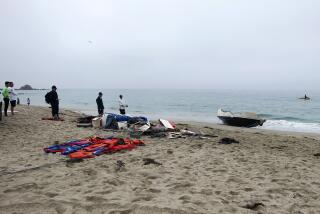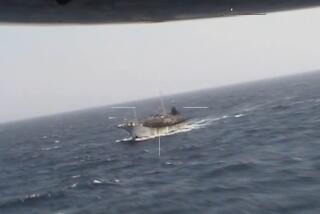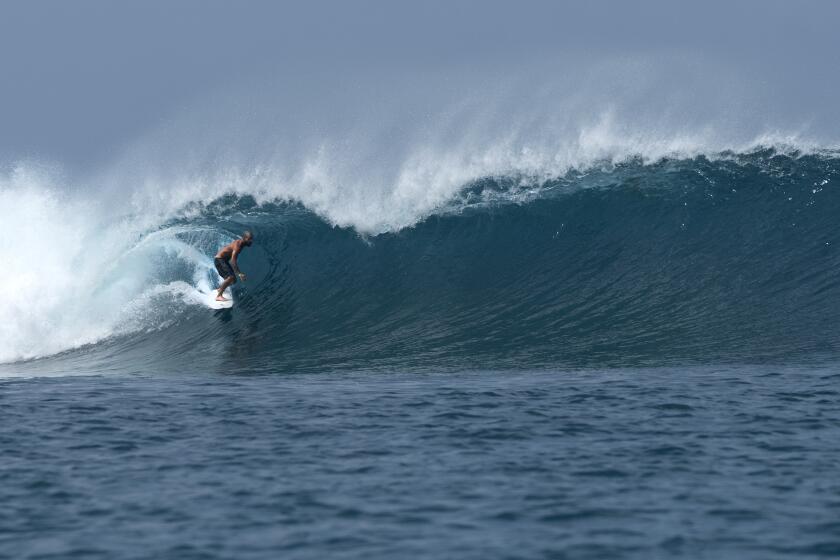On the trail of the sea bass pirates: High stakes on the high seas
Four Thai customs agents in a gunmetal-gray speedboat slowly circle a decrepit fishing vessel, its huge white hull streaked with filth and rust.
Anchored a mile off this resort island’s southern coast, it towers over them like a ghost ship. A man in sunglasses appears behind the bridge’s windows. The government agents squint to make him out.
The government has forbidden the 625-ton boat to set sail, but it has also ordered the agents not to board. So they continue to circle — and stare.
“We can’t figure out where the Kunlun came from,” Phuket customs chief Charoen Chamniklang says later.
What they can figure out is that the Kunlun — one of many names the ship has used — is suspected of holding some $5 million worth of illicit “Chilean sea bass,” a fish that is neither bass nor necessarily from Chile but is valuable enough to be at risk of overfishing.
And it isn’t the first time, nor apparently the last.
For decades, overfishing has depleted global fishing stocks and threatened the existence of entire species. International organizations have made headway in recent years with regulations that rein in the most rapacious practices, such as fishing with massive drift nets that ensnare everything in their path.
But in many parts of the world, especially little-patrolled stretches of the remotest ocean, pirates continue to operate — using rust-bucket vessels and a shifting assortment of national flags, and catching protected fish with banned equipment.
To combat them, environmental organizations and law enforcement authorities engage in high-stakes cat-and-mouse games on the high seas. Before its arrival in Thailand, the Kunlun had led pursuers on an epic, 900-mile chase.
Now, anchored in the turquoise water off Phuket, the ship’s operators were making one thing clear: They weren’t going to make this easy.
::
Siddharth Chakravarty says he first encountered the Kunlun on an overcast January day on a remote stretch of the Antarctic Ocean that he calls the “Shadowlands,” international waters about 2,400 miles southwest of Australia.
Many commercial fishermen consider the choppy, iceberg-dotted waters forbiddingly dangerous. But the ocean teems with Arctic toothfish, one of two species (along with Patagonian toothfish) that is marketed under the more appealing name of Chilean sea bass. Chakravarty, an energetic Indian environmentalist, was there to stake out any unauthorized fishing boats seeking to harvest the fish.
Chakravarty, 32, is a volunteer captain for the Sea Shepherd Conservation Society, a nongovernmental organization based on Washington state’s San Juan Island. The group’s mission, according to its website, is to take “direct action” against “illegal activities on the high seas.”
The group, founded in 1977 by Canadian activist Paul Watson, is best known as the subject of the reality TV show “Whale Wars,” which has documented its often extreme efforts to thwart Japanese whalers in the Antarctic Ocean. The whalers sued Sea Shepherd, leading to a 2013 injunction that memorably referred to the activists as pirates without “a peg leg or an eye patch,” and forbade their ships from coming near the whalers’ vessels.
Yet some analysts say the group has proved instrumental in drawing attention to oceanic issues that governments aren’t willing or able to fix.
Fishing in the Antarctic Ocean is regulated by the Convention on the Conservation of Antarctic Marine Living Resources, or CCAMLR, an international fisheries management body that comprises representatives from 24 nations and the European Union.
The Australia-based organization licenses vessels, tracks their movements and sets catch limits. But it faces a constant battle with “illegal, unreported and unregulated” ships, which fish with banned gill nets and fly flags of non-CCAMLR nations to dodge regulators.
The United Nations estimates such ships cause global economic losses of up to $23 billion a year.
In the 1990s, when the market for Chilean sea bass boomed, ships began pursuing the species with a gold-rush-like mentality, experts say, depleting toothfish populations. By 2000, twice as much illegally caught Chilean sea bass was sold on the market as legal catch, according to a U.S. government report.
Since then, CCAMLR has tightened regulations, reducing the number of illegal fishing vessels in its area and helping to stabilize toothfish populations. Yet some boats continue to ply the waters with false flags and illegal nets, according to the organization.
In early December, Chakravarty had just set sail from Wellington, New Zealand, with a volunteer crew of 30 on the Sam Simon, a 182-foot oceanographic observation ship with a shark’s maw painted on its bow. His aim was to track down and thwart the Kunlun and five other vessels suspected of illegal fishing.
Even before Chakravarty encountered the Kunlun, he and his crew recovered abandoned gill nets from another illegal ship — nearly 45 miles of nylon mesh laden with 50 tons of marine life, including rays, jellyfish, grenadiers, crabs and about 1,200 toothfish.
On Jan. 13, Chakravarty said in a phone interview, he learned that a New Zealand naval patrol had spotted the Kunlun and two others hauling gill nets “laden with toothfish” in a CCAMLR-protected area, about 70 miles from the Antarctic coast.
All three flew the flags of Equatorial Guinea, not a CCAMLR member, though the country’s government denied that the ships were registered there, Commodore John Campbell of the Royal New Zealand Navy said in an interview.
Chakravarty steered the Sam Simon toward the area where the ships had been seen.
“We had double watches, lookouts on the bridge, radars going,” he said. “We searched through the night.”
At about 8 a.m. the next day, the Sam Simon’s first mate spotted the Kunlun on radar.
“My first impression was that this ship shouldn’t have been sailing. It was a real rust bucket,” Chakravarty said. The ship’s curtains were drawn, its captain a mystery. Chakravarty tried calling him on his ship’s radio.
“You don’t have permission to fish here,” he said, warning that he would physically block any attempts by the ship to deploy its nets.
The Kunlun remained silent and maintained its course for the next six days. “We chased her till she was about 900 miles away from where we had found her,” Chakravarty said.
Eventually, Chakravarty peeled off to Mauritius, and the Kunlun sailed to Australia’s Cocos Islands, where on Feb. 26, customs officials boarded the ship, found a large load of frozen fish and left without filing any charges or complaints. Australia’s parliamentary secretary to the agriculture minister, Richard Colbeck, told local news media that Australia was legally barred from arresting the captain and crew because they were on the high seas.
::
When the ship entered Thailand’s waters off Phuket on March 6, local authorities didn’t notice anything out of the ordinary. The captain told authorities that his ship was the Taishan, the name emblazoned on its hull, and that it hailed from Indonesia.
He said it carried 182 tons of frozen black grouper that he’d purchased from a smaller boat at sea. Customs let the ship drop anchor, and the cargo was hauled by truck to the Songkhla deep-water port, a busy spot on the Thailand-Vietnam border.
The next day, Panya Chaichana, an official with the Phuket Marine Police, received a notice from Interpol seeking information about the owners who “profit from the illegal actions of the vessel Kunlun.” It accused the ship of fishing with banned nets in a protected area and of committing fraud by changing its “name, national registration (‘flag’) and other identifying characteristics.”
According to Interpol, the 42-year-old Kunlun has been called the Chang Bai, the Hongshui, the Corvus, the Galaxy, the Red Moon and the Dorita. It’s flown the flags of Equatorial Guinea, Indonesia, Tanzania, North Korea, Panama and Sierra Leone. It’s been registered to at least five companies, several of them based in Latin America.
Recently, authorities in Spain and New Zealand announced that evidence gathered by the New Zealand navy has linked the Kunlun and two other ships to a Spanish company, Vidal Armadores, a family-run business that international authorities have suspected of operating illegal fishing vessels for more than a decade, according to news reports in the two countries.
The Kunlun’s captain and crew could not be reached for comment. A lawyer for Vidal Armadores told the Associated Press this year that the company no longer owned fishing boats.
Spanish authorities reportedly plan to fine the company more than $12 million and prosecute 50 Spanish crew members for fishing illegally in Antarctica — said to be the harshest punishment for illegal fishing in European Union history.
Thailand was more forgiving, even though customs officials identified the catch as toothfish, not grouper, and marine authorities confirmed that the ship was the Kunlun, not the Taishan.
Chaichana, when he eventually boarded the boat, said he found no illegal fishing gear. Songkhla port authorities could not determine the cargo’s origins or how it was caught. The ship’s crew was allowed to leave Thailand.
Critics say Thailand, one of the world’s biggest seafood exporters but not a CCAMLR member, has done little to halt illegal fishing in its waters, not to mention the high seas. On April 21, the European Union handed the country a “yellow card” for alleged negligence in combating unlawful fishing practices, threatening a seafood embargo by October if it did not take steps to improve.
“If Thailand follows its own laws, the only crime which [the Kunlun] committed was mislabeling the seafood,” said Michael Gravitz, director of policy and legislation at the Marine Conservation Institute in Washington. “For that, they could get slapped with a $3,000 fine. But that’s for a $5-million cargo. And this boat has been on the international list of pirate fishing boats for a long time.”
Authorities at Songkhla said they planned to return the fish after the ship’s owner paid about $160,000 in storage fees. It could turn up on restaurant menus soon.
Pramok Urawan, a representative of a Phuket-based agency hired by the ship, said the captain and crew have since been replaced by three Spanish men, all of whom remain aboard the vessel. He said the ship plans to sail to Indonesia.
“They’re just waiting to leave,” he said.
More to Read
Sign up for Essential California
The most important California stories and recommendations in your inbox every morning.
You may occasionally receive promotional content from the Los Angeles Times.










